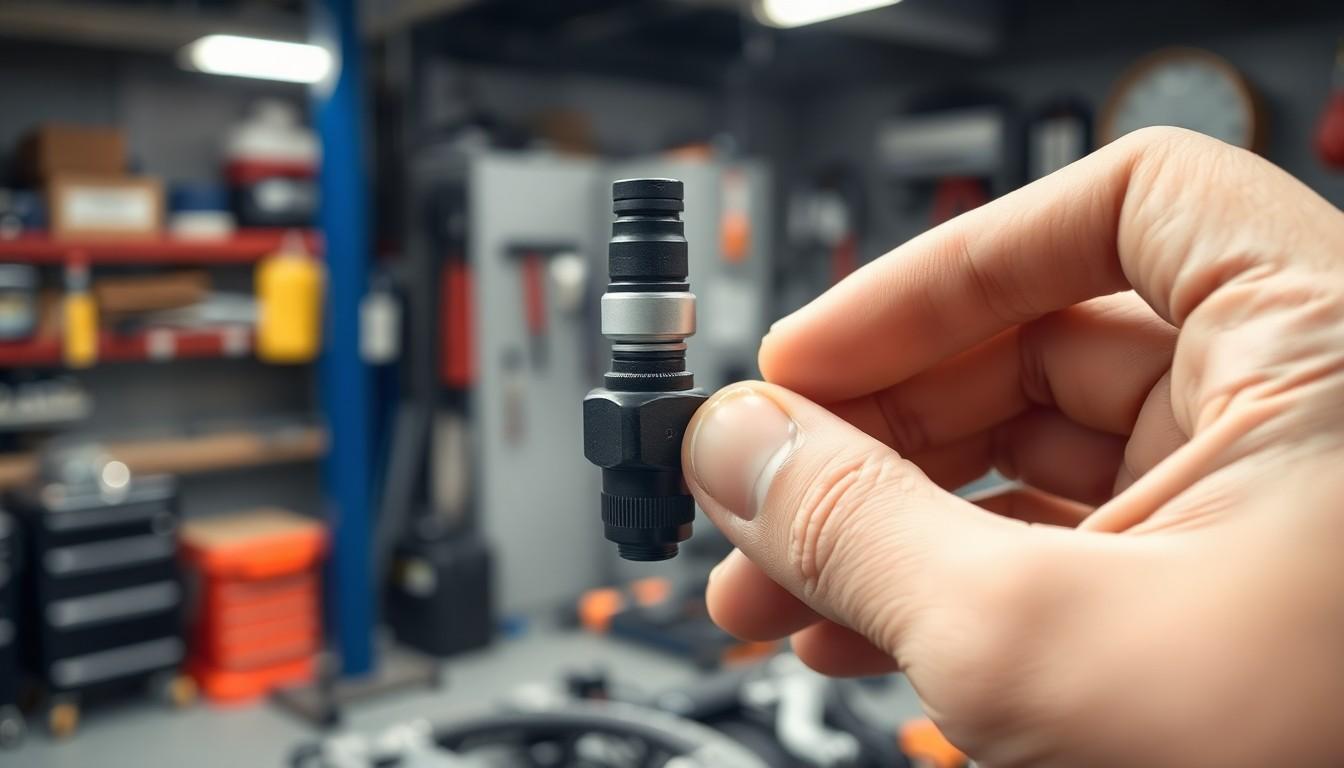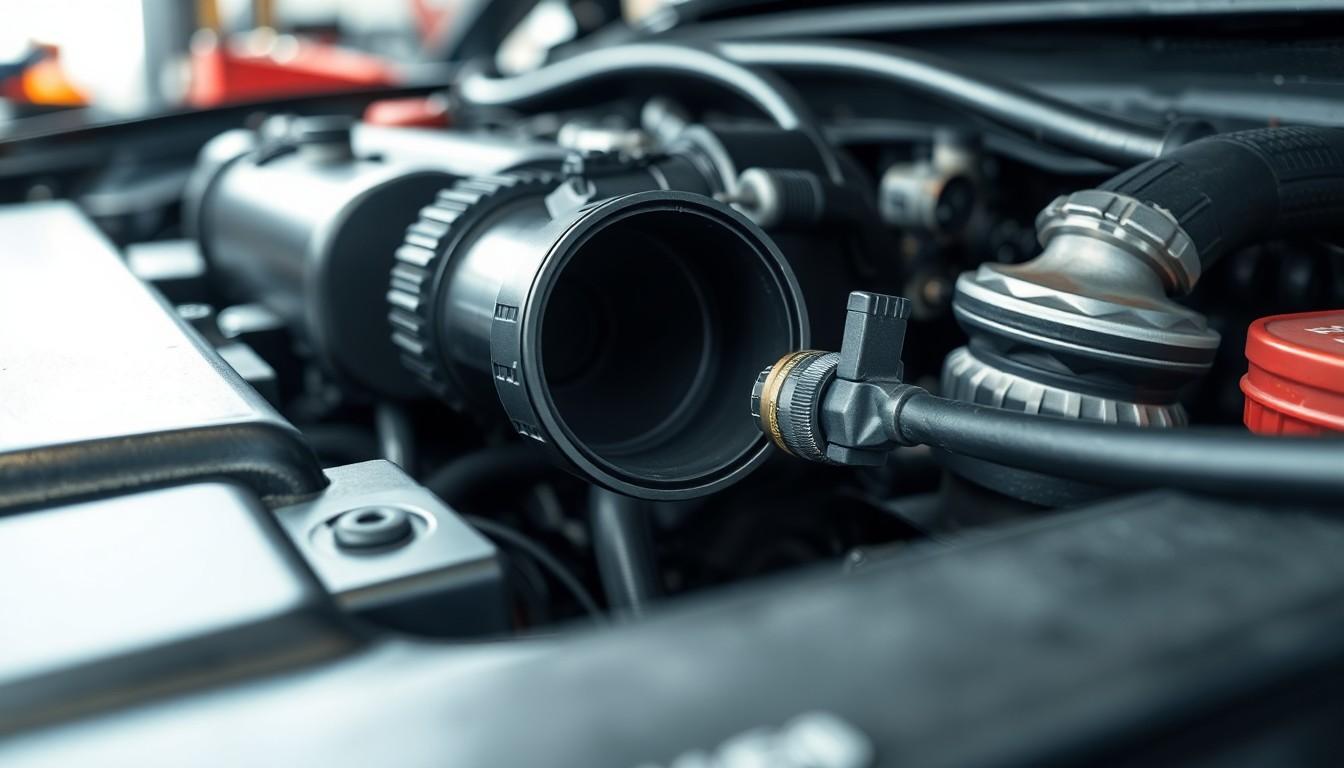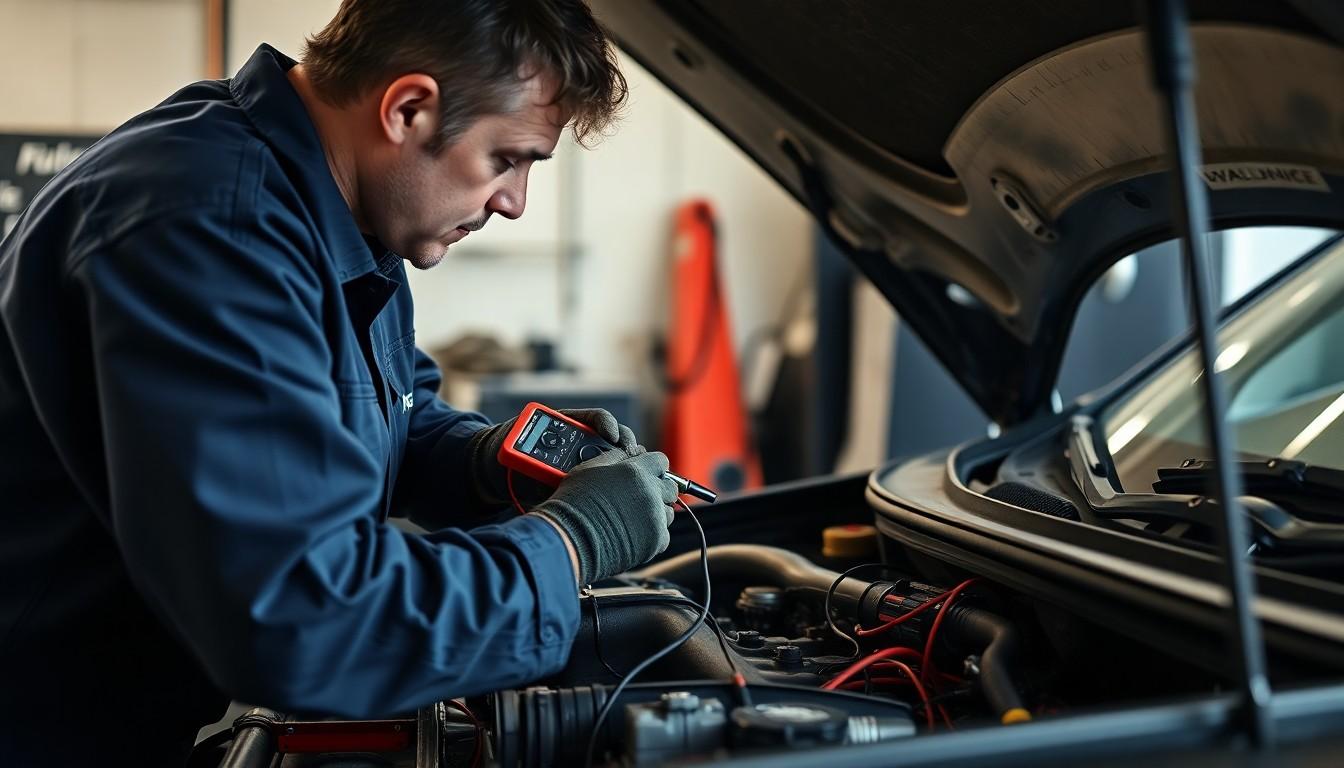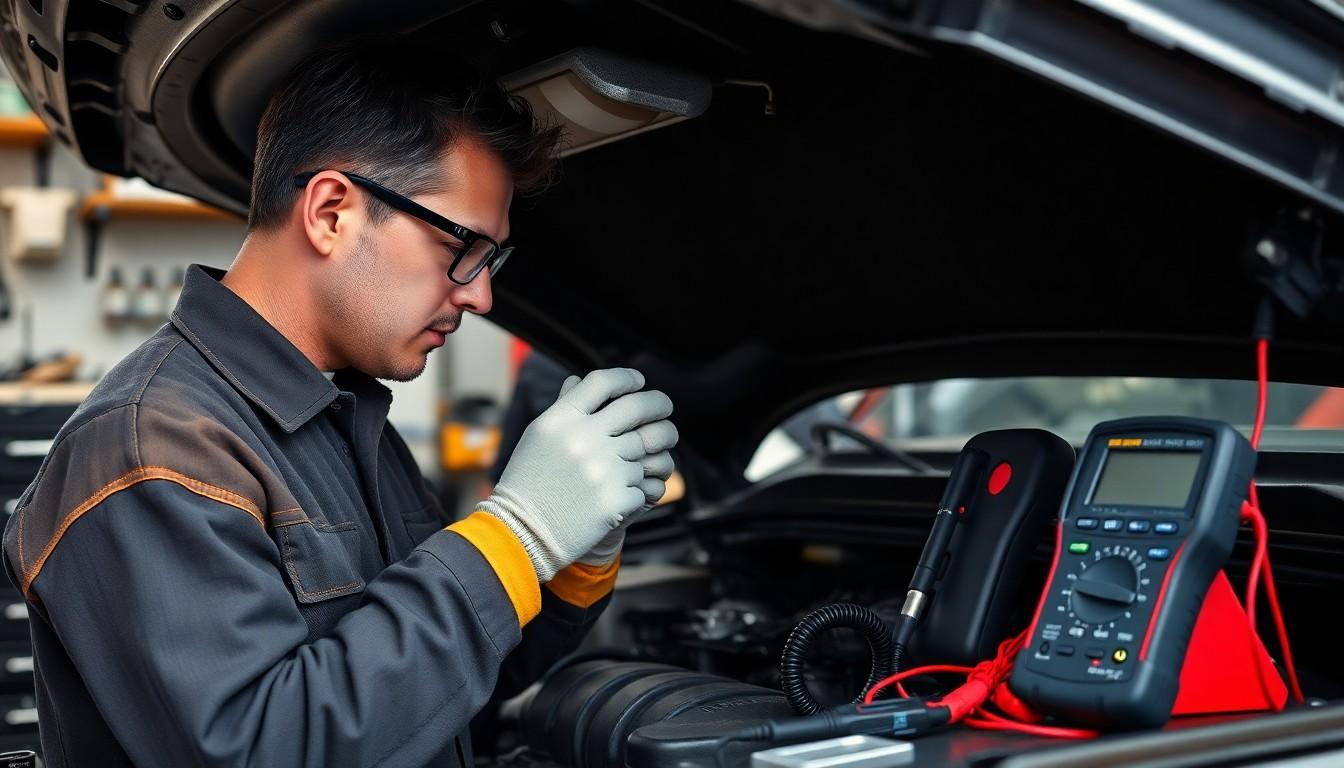Is your vehicle experiencing mysterious stalling, hesitating during acceleration, or struggling to start? These frustrating symptoms might point to a faulty camshaft position sensor. This small but crucial component plays a vital role in your engine’s timing system, and when it fails, it can cause a host of performance issues.
We’ll guide you through simple yet effective methods to diagnose a bad camshaft position sensor without necessarily being a mechanic. With just a few basic tools and our step-by-step instructions, you’ll be able to identify whether this sensor is the culprit behind your car troubles. Catching this problem early can save you from costly repairs and unexpected breakdowns down the road.
What Is a Camshaft Position Sensor and How Does It Work
A camshaft position sensor is a crucial electronic device that monitors the rotation of the camshaft and transmits this data to the engine control module (ECM). Located near the camshaft, this sensor plays a vital role in ensuring optimal engine performance by helping maintain precise ignition timing and fuel injection sequences.
The sensor operates using electromagnetic principles to track the camshaft’s position. As the camshaft rotates, the lobes pass by the sensor, creating changes in the magnetic field that generate electrical signals. These signals are then sent to the ECM, which uses this information to determine the position of the pistons and valves.
Modern vehicles rely on this sensor to:
- Synchronize fuel injection timing
- Establish proper ignition timing
- Control variable valve timing systems
- Manage overall engine performance
Inside the sensor, you’ll typically find either a Hall effect sensor or a magnetic reluctance sensor. Hall effect sensors use voltage changes to detect camshaft position, while magnetic reluctance sensors use magnetic field variations to generate AC voltage signals.
The ECM continuously analyzes data from the camshaft position sensor alongside information from other sensors like the crankshaft position sensor. This integrated approach ensures that fuel injection and spark plug firing occur at exactly the right moments in the engine cycle, maximizing efficiency and power output.
Understanding this component’s function helps explain why a failing camshaft position sensor can cause many of the symptoms we discussed earlier, including engine misfires, poor acceleration, and starting problems.
Common Symptoms of a Failing Camshaft Position Sensor

Recognizing the symptoms of a failing camshaft position sensor (CMP) enables early detection and prevents more serious engine problems. These distinct warning signs typically appear when the sensor begins to malfunction and can’t properly monitor camshaft position.
Engine Misfires and Rough Idling
Engine misfires and rough idling are telltale indicators of a faulty camshaft position sensor. When the sensor fails, the engine control module (ECM) receives inaccurate data about the camshaft’s position and speed, leading to improper fuel injection timing. The engine struggles to maintain consistent combustion, resulting in noticeable vibrations and irregular operation at idle. You’ll often feel these vibrations throughout the vehicle’s cabin when stopped at traffic lights or in park.
Hard Starting or No-Start Conditions
A deteriorating camshaft position sensor commonly causes difficult starting or complete starting failure. The vehicle might crank longer than normal before starting or fail to start altogether even though the engine turning over. This occurs because the ECM relies on precise camshaft position data to determine the correct timing for fuel injection and spark delivery. Without this critical information, the engine’s timing is compromised, making ignition difficult or impossible in severe cases.
Reduced Engine Performance
Performance issues frequently develop when the camshaft position sensor begins failing. Drivers experience sluggish acceleration, unexpected power loss during operation, and decreased fuel efficiency. The ECM can’t optimize fuel injection and ignition timing without accurate camshaft position information, forcing it to operate in a “safe mode” with conservative timing settings. This protective measure prevents potential engine damage but significantly reduces performance and responsiveness during daily driving.
Check Engine Light Illumination
The check engine light activates when the ECM detects inconsistencies in the camshaft position sensor’s data. This warning light serves as an early alert system for sensor-related problems before more noticeable performance issues develop. Using an OBD-II scanner reveals exact trouble codes associated with the camshaft position sensor, typically ranging from P0340 to P0349 depending on your vehicle model. These diagnostic codes provide valuable information about the exact nature of the sensor failure, helping pinpoint whether the issue involves the sensor itself, its circuit, or related components.
Tools Needed to Test a Camshaft Position Sensor

Testing a camshaft position sensor requires exact diagnostic equipment to accurately assess its functionality. Here’s a comprehensive list of the essential tools you’ll need to perform a thorough evaluation:
Diagnostic Equipment
- OBD-II Scanner: A quality code reader allows you to check for trouble codes specifically related to the camshaft position sensor, such as P0340 or P0345, which directly indicate sensor circuit issues.
- Digital Multimeter: This versatile tool measures voltage supply to the sensor (typically 5-12V) and tests resistance values according to manufacturer specifications.
- Oscilloscope: For advanced diagnosis, an oscilloscope displays the actual signal output from the sensor, helping identify weak or erratic signals that might not trigger fault codes.
Reference Materials
- Vehicle-Exact Wiring Diagram: Essential for locating the correct wires to test and understanding the proper electrical specifications for your particular vehicle model.
- Service Manual: Contains the manufacturer’s resistance specifications, voltage requirements, and proper testing procedures for your exact camshaft position sensor.
Additional Tools
- Basic Hand Tools: Include socket sets, screwdrivers, and pliers for accessing and removing the sensor, as sensor locations vary significantly between vehicle makes and models.
- Replacement Sensor: Having a new or known good sensor on hand enables performing a swap test, one of the most definitive ways to confirm a faulty sensor.
- Safety Equipment: Gloves and safety glasses protect you while working around hot engine components or handling electrical connections.
Access to these tools ensures you can perform comprehensive testing of your camshaft position sensor, from basic code reading to advanced signal analysis. The combination of diagnostic equipment and reference materials provides everything needed to make an accurate determination about your sensor’s condition.
How to Locate Your Vehicle’s Camshaft Position Sensor

General Location Information
Camshaft position sensors typically reside near the camshaft on either the cylinder head or engine block. The exact position varies significantly depending on your vehicle’s make, model, and engine configuration. Many manufacturers place the sensor where it can directly monitor the camshaft’s rotation, providing accurate timing information to the engine control module (ECM).
Step-by-Step Location Process
Finding your camshaft position sensor involves a systematic approach for accurate identification:
- Check your vehicle’s manual – Your repair or owner’s manual contains exact diagrams showing the precise location of the CMP sensor for your particular model
- Follow the wiring harness – Trace the electrical connectors that link to the engine control module as they’ll lead to the sensor
- Examine the camshaft area – Look around the cylinder head or top of the engine where the sensor must be positioned to monitor camshaft movement
- Identify the sensor’s appearance – The CMP sensor usually resembles a small cylindrical component with an electrical connector attached
Visual Inspection Techniques
Once you’ve located the camshaft position sensor, perform a thorough visual assessment to spot potential issues. Examine the sensor for physical damage including cracks, corrosion, or oil contamination. Inspect all wiring connections for signs of wear, fraying, or loose terminals. Check the sensor’s mounting to ensure it’s secure, as vibration can cause intermittent performance problems. Oil leaks around the sensor often indicate failed seals that might allow contaminants to compromise its function.
Testing the Camshaft Position Sensor with a Multimeter

A multimeter provides a reliable way to test your camshaft position sensor’s functionality without expensive diagnostic equipment. Testing with this versatile tool helps determine whether the sensor needs replacement or if another component might be causing your engine issues.
Resistance Test Method
The resistance test measures the internal electrical integrity of your camshaft position sensor. First, locate the sensor near the camshaft or on the cylinder head, ensuring the engine is cool and the ignition is off. Disconnect the electrical connector from the CMP sensor to isolate it for testing. Set your multimeter to the ohms (Ω) function before connecting the leads to the sensor’s terminals. Compare your reading with the specifications in your vehicle’s repair manual – readings that differ significantly from factory specs indicate a potentially faulty sensor. This simple test effectively evaluates the sensor’s internal circuitry without requiring the engine to run.
Voltage Output Test Method
The voltage output test examines the sensor’s actual performance while the engine operates. Begin by locating the CMP sensor and its wiring harness, then set your multimeter to the DC voltage function (typically using the 20V range). Connect one multimeter lead to the sensor’s output wire and the other to a ground point on your vehicle. Start the engine and allow it to idle while monitoring the voltage reading on your multimeter. A properly functioning CMP sensor produces a consistent voltage signal between 0.5 and 5 volts, varying by vehicle model and sensor type. Erratic readings, no signal, or measurements outside the expected range strongly suggest a malfunctioning sensor. This ever-changing test provides valuable insight into how the sensor performs under actual operating conditions, revealing intermittent issues that static tests might miss.
Using an OBD-II Scanner to Diagnose Sensor Issues

An OBD-II scanner offers the most accurate method to diagnose a faulty camshaft position sensor. This diagnostic tool connects directly to your vehicle’s computer system and retrieves valuable error codes that pinpoint exact issues with the sensor.
Connecting the OBD-II Scanner
OBD-II scanners work with virtually all vehicles manufactured after 1996, when this diagnostic system became standard equipment. Locate your vehicle’s OBD-II port, typically found underneath the steering column on the driver’s side. Connect the scanner securely to this port, ensuring a proper connection before proceeding with the diagnostic process. Turn the ignition key to the “on” position without starting the engine to power up the vehicle’s electronic systems.
Reading and Interpreting Error Codes
Once connected, your OBD-II scanner retrieves trouble codes stored in the engine control module (ECM). Exact codes indicate camshaft position sensor problems, including P0340 (Circuit Malfunction), P0341 (Range/Performance), P0342 (Low Input), P0343 (High Input), and P0344 (Intermittent). These codes provide detailed information about the exact nature of the sensor issue. For example, a P0342 code indicates the sensor circuit is sending an abnormally low voltage signal to the ECM, while P0343 shows an excessively high voltage.
| Error Code | Description |
|---|---|
| P0340 | Camshaft Position Sensor Circuit Malfunction |
| P0341 | Camshaft Position Sensor Circuit Range/Performance |
| P0342 | Camshaft Position Sensor Circuit Low Input |
| P0343 | Camshaft Position Sensor Circuit High Input |
| P0344 | Camshaft Position Sensor Circuit Intermittent |
Confirming the Diagnosis
Error codes from your scanner should align with physical symptoms of a failing camshaft position sensor. Cross-reference the scanner data with issues you’ve experienced, such as engine stalling, rough idling, starting difficulties, or misfires. Poor fuel economy and unexpected transmission shifting problems also commonly accompany camshaft position sensor failures. The presence of both diagnostic codes and matching symptoms provides stronger confirmation of sensor malfunction.
Testing After Diagnosis
Clear the trouble codes using your OBD-II scanner’s reset function after identifying potential issues. Take your vehicle for a test drive to see if the same codes return, which confirms an ongoing problem with the camshaft position sensor. Persistent codes, especially when accompanied by the same performance issues, strongly indicate sensor replacement is necessary. This verification step helps distinguish between intermittent glitches and genuine sensor failures.
Visual Inspection of the Camshaft Position Sensor

Visual inspection serves as the first critical step in diagnosing a faulty camshaft position sensor. This process requires minimal tools but provides valuable insights into the sensor’s condition before moving on to more complex diagnostic methods.
Checking for Physical Damage and Wiring Issues
Locating the camshaft position sensor is your initial task, typically found near the camshaft or mounted directly on the cylinder head. Examine the sensor body carefully for any cracks, dents, or corrosion that might compromise its functionality. Pay special attention to the sensor’s electrical connector, looking for signs of wear, disconnection, or corrosion at the terminal points.
The mounting bracket and securing screws deserve thorough inspection to ensure they’re properly tightened, as loose mounting can cause erratic sensor readings. Follow the wiring harness connected to the sensor and check for cuts, frays, or burn marks that could interrupt signal transmission. Clean connections are essential for proper sensor operation, so remove any visible corrosion using an appropriate electrical contact cleaner.
Oil leaks around the sensor area often indicate seal failure, potentially allowing engine oil to contaminate the sensor’s internal components. During your inspection, note any unusual discoloration on the sensor or surrounding components, which might indicate overheating issues. Verify that no debris or foreign objects are obstructing the sensor’s path or blocking its ability to read the camshaft position accurately.
For a comprehensive assessment, use an OBD2 scanner to check for trouble codes such as P0340, P0341, or P0342, which specifically relate to camshaft position sensor problems. These diagnostic codes provide valuable confirmation of your visual findings and help pinpoint exactly which aspect of the sensor system is failing.
When to Replace vs. Clean Your Camshaft Position Sensor

When to Replace Your Camshaft Position Sensor
Replacing your camshaft position sensor becomes necessary under exact circumstances. Physical damage such as cracks, severe corrosion, or broken components on the sensor body indicates immediate replacement is required. OBD-II scanner readings displaying persistent trouble codes like P0340 (Camshaft Position Sensor Circuit Malfunction) or P0341 (Camshaft Position Sensor Circuit Range/Performance) strongly suggest replacement rather than cleaning. Failed electrical tests showing readings outside manufacturer specifications confirm the sensor has reached the end of its useful life. Sensors exhibiting intermittent performance issues that return even after cleaning typically need replacement to restore proper engine function. Multiple symptoms occurring simultaneously—including hard starting, rough idling, and engine misfires—generally point to a sensor that needs to be replaced rather than cleaned.
When to Clean Your Camshaft Position Sensor
Cleaning your camshaft position sensor can resolve certain problems without the expense of replacement. Light dirt accumulation or surface contamination on the sensor often responds well to careful cleaning with appropriate electrical cleaner. Minor corrosion on the electrical connections can frequently be addressed with gentle cleaning using a soft brush and electrical contact cleaner. Loose connections causing intermittent sensor readings typically improve after cleaning the contact points and securing all wiring. Temporary or recent onset symptoms sometimes indicate the need for cleaning rather than full replacement, especially if the check engine light has only recently illuminated. Sensors exposed to oil leaks or engine grime build-up generally benefit from thorough cleaning, which can restore proper functionality without replacement costs.
How to Clean Your Camshaft Position Sensor
Cleaning a camshaft position sensor requires attention to detail and proper materials. Disconnect your vehicle’s battery before beginning any work on the sensor to prevent electrical shorts or ECM damage. Remove the sensor carefully after noting its exact position and orientation to ensure correct reinstallation. Apply electrical contact cleaner to a soft brush or lint-free cloth, never spraying directly onto the sensor itself. Gently clean the sensor body, paying special attention to the magnetic tip or sensing element without applying excessive pressure. Examine the electrical connector for corrosion or debris, cleaning it thoroughly with the same electrical cleaner. Allow all components to dry completely before reinstallation, as moisture can cause electrical issues or false readings. Reconnect the sensor firmly, ensuring the connector clicks or locks into place securely. Perform a test drive after cleaning to determine if symptoms have improved before considering replacement.
Tools Needed for Cleaning vs. Replacement
Cleaning and replacement procedures require different tool sets for effective completion. Cleaning necessitates electrical contact cleaner specifically designed for sensitive electronic components, soft brushes for gentle debris removal, and lint-free cloths to prevent contamination. Replacement typically demands socket sets or wrenches matching your vehicle’s specifications, a torque wrench for proper installation tightness, and potentially specialized tools depending on sensor location. Both procedures benefit from basic hand tools for disconnecting electrical connectors and removing mounting hardware. Safety equipment including gloves and eye protection protects against chemicals and debris during either process. An OBD-II scanner proves invaluable for both scenarios—confirming the issue before cleaning and verifying resolution after replacement.
Professional Diagnosis vs. DIY Testing

Professional diagnosis and DIY testing offer different approaches to determining if your camshaft position sensor has failed. Each method has distinct advantages depending on your mechanical expertise and available tools.
Professional Diagnosis Methods
Professional mechanics rely on specialized equipment and expertise to accurately diagnose camshaft position sensor issues. Using an OBD-II scan tool, technicians can identify exact trouble codes like P0340 (Camshaft Position Sensor Circuit) that directly point to CMP problems. Trained professionals conduct thorough visual inspections of the sensor and its wiring to detect damage, corrosion, or wear that might escape an untrained eye. Specialized signal testing equipment allows mechanics to measure the exact output from the CMP sensor to verify if it’s sending accurate data to the engine control module.
DIY Testing Approaches
DIY testing provides cost-effective options for those comfortable working with vehicles. The check engine light serves as your first indicator—connect an affordable OBD-II code reader to check for CMP-related codes such as P0340. Observing your vehicle’s behavior reveals telltale signs of a failing camshaft position sensor:
- Hard starting or extended cranking time
- Sudden engine stalls, especially at idle
- Rough or inconsistent idling patterns
- Hesitation when accelerating from a stop
- Decreased fuel economy
- Frequent engine misfires
- Erratic automatic transmission shifting
- Strong smell of unburned fuel
Visual inspection remains crucial even for DIY testing—check the sensor and connected wiring for visible damage and secure connections. With a multimeter, you can test the CMP’s voltage output against specifications in your vehicle’s repair manual. Weak or inconsistent readings often indicate sensor failure. Swap testing (replacing the suspect sensor with a known good one) provides a definitive way to confirm if the CMP is truly the culprit.
Choosing the Right Method
Professional diagnosis works best for complex issues or when multiple symptoms overlap with other potential problems. Since failing camshaft position sensors share symptoms with crankshaft position sensors and ignition system issues, professional testing equipment can differentiate between these similar problems. DIY testing proves most effective for obvious sensor failures or when clear trouble codes point directly to the CMP sensor. Combining both approaches—starting with basic DIY tests before seeking professional help for confirmation—often provides the most cost-effective diagnostic strategy.
Conclusion
Diagnosing a bad camshaft position sensor doesn’t have to be complicated with the right approach. We’ve walked through various testing methods from visual inspection to using multimeters and OBD-II scanners that can help pinpoint the issue.
Remember that symptoms like engine misfires poor acceleration and difficulty starting your vehicle are key indicators of potential sensor failure. By combining DIY testing with professional diagnostics when needed you’ll save time and money while keeping your engine running smoothly.
Acting promptly when you notice these warning signs can prevent more serious engine damage down the road. With proper tools and the knowledge we’ve shared you’re now equipped to confidently check your camshaft position sensor and make informed decisions about cleaning or replacement.
Frequently Asked Questions
What is a camshaft position sensor and why is it important?
A camshaft position sensor is an electronic device that monitors camshaft rotation and sends data to the engine control module (ECM). It’s crucial for maintaining precise ignition timing and fuel injection sequences. The sensor operates using electromagnetic principles and helps synchronize fuel injection, establish proper ignition timing, and manage overall engine performance. Without it functioning correctly, your engine can experience numerous performance issues.
What are the common symptoms of a faulty camshaft position sensor?
Common symptoms include engine misfires, rough idling, hard starting or no-start conditions, reduced engine performance (sluggish acceleration and decreased fuel efficiency), and an illuminated check engine light. These issues occur because the ECM receives inaccurate data, leading to improper fuel injection timing and compromised ignition timing. When the sensor fails, the ECM often operates in “safe mode” to prevent engine damage.
What tools do I need to test a camshaft position sensor?
You’ll need an OBD-II scanner to check trouble codes, a digital multimeter for measuring voltage and resistance, and possibly an oscilloscope for advanced signal analysis. Reference materials like vehicle-specific wiring diagrams and service manuals are essential. Basic hand tools for accessing the sensor, a replacement sensor for swap testing, and safety equipment (gloves and safety glasses) are also recommended.
Where is the camshaft position sensor located?
The camshaft position sensor typically resides near the camshaft on either the cylinder head or engine block. Its exact position varies by vehicle make and model. To locate it, check your vehicle’s manual, follow the wiring harness to the ECM, examine the camshaft area, or identify it by its characteristic appearance. Most sensors are cylindrical with an electrical connector attached.
How can I test a camshaft position sensor with a multimeter?
You can test using two methods: the resistance test and voltage output test. For resistance testing, disconnect the sensor, set your multimeter to ohms, and measure between specified terminals (compare readings to manufacturer specs). For voltage testing, connect the multimeter to the sensor wiring while it’s connected, set to DC volts, and check if voltage fluctuates as the engine runs, indicating proper function.
How do I use an OBD-II scanner to diagnose sensor issues?
Connect the scanner to your vehicle’s OBD-II port (usually under the steering column) and turn on the ignition. Look for camshaft position sensor-related codes such as P0340, P0341, P0342, P0343, and P0344. These codes indicate specific sensor problems. Cross-reference these codes with physical symptoms you’ve experienced. After repairs, clear the codes and retest to confirm the issue is resolved.
Is visual inspection important when diagnosing sensor problems?
Yes, visual inspection is crucial as the first diagnostic step. Check for physical damage to the sensor body (cracks/corrosion), ensure the electrical connector is securely attached, verify the mounting bracket is tight, and look for oil leaks around the sensor area. Using an OBD-II scanner alongside visual inspection helps confirm findings and pinpoint specific sensor system failures.
When should I replace versus clean the camshaft position sensor?
Replace the sensor if you find physical damage, persistent trouble codes, failed electrical tests, or multiple symptoms indicating sensor failure. Cleaning may be sufficient for light dirt accumulation, minor corrosion, or loose connections. When cleaning, use appropriate materials (electrical contact cleaner), ensure components are completely dry before reinstallation, and always disconnect the battery first as a safety precaution.
Can I diagnose a bad camshaft position sensor myself or should I see a mechanic?
You can perform basic diagnostics yourself if you’re comfortable working with vehicles and have the necessary tools (OBD-II scanner, multimeter). However, professional mechanics offer specialized equipment and expertise for accurate diagnosis. A combined approach often works best—start with basic DIY tests, then seek professional help for confirmation if needed. This provides the most cost-effective diagnostic strategy.

